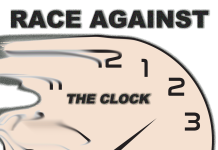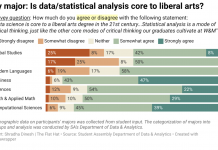
In 2014, former Director of Procurement Services Greg Johnson said that the relationship between VCE and the College of William and Mary has been going on for “eons.”
Four years later, little has changed about this relationship from an institutional perspective, even as student groups advocate for reform.
Under section 53.1-41 of the Code of Virginia, the Virginia Department of Corrections must provide state inmates with opportunities to work. Virginia Correctional Enterprises was founded by the Virginia General Assembly in 1934 with the aim of being a self-sustaining program that would provide jobs and work skills to enhance employment prospects for convicted felons once they completed their sentences and reintegrated into their communities.
According to the law which established VCE, all institutions and agencies of the state are required to purchase goods produced or manufactured by inmates. A 1999 report explains that Virginia institutions can only be free from this obligation if VCE does not offer the institution’s desired product.
Although the majority of VCE’s contracting is with state institutions, VCE is allowed to engage in joint ventures with private companies and to sell goods and services in the open market.
As a participating Virginia state-funded institution, the College is bound by law to purchase inmate-produced goods and services from VCE. According to fiscal year budget reports from 2014-17, the College has spent varying amounts on its VCE contract.
Erma Baker, the director of procurement at the College since November 2016, said the fluctuation is due in part to the cycle of furniture replacement, as well as to new constructions projects. VCE is able to contract for items like basic office furniture, Baker said, but specialized items — such as medical products for the new Integrated Wellness Center, or the Virginia Institute of Marine Science’s new consolidated lab building — are found elsewhere in the market.
In the past four fiscal years, the College has spent $1,176,246 on average at VCE, primarily for the purchase of furniture, but also for products like business cards and other services. And while 2015 saw a decrease in spending compared to 2014, the last two years have seen the amount of money spent on VCE products increase. The College spent a total of $1,186,989 on VCE products in 2014, $511,425 in 2015, $1,457,569 in 2016 and $1,549,000 in 2017.
In recent years, student organizations have taken a public stance against the College’s purchase of VCE products and services. Hailey Ulrich ’20 and Shannon Lewis ’20, the coordinators of the College’s Amnesty International chapter, said that they wanted prisoners to be paid a fair wage, which they believe is above their current compensation.
“We are coming from a human rights perspective, ensuring that all citizens are treated like citizens regardless of incarceration, ensuring dignity, which includes being paid more than $0.50-$0.80 per hour,” Hailey Ulrich ’20 said.
“It’s a complex situation in Virginia that’s tied to the law — it’s not about just tackling one institution,” Ulrich said. “We are coming from a human rights perspective, ensuring that all citizens are treated like citizens regardless of incarceration, ensuring dignity, which includes being paid more than $0.50-$0.80 per hour.”
Lewis echoed this idea that is difficult to separate the legislative framework from the human rights issues.
“It’s an incentive to keep putting more people in prison, to keep up quotas, and Virginia is profiting,” Lewis said. “[VCE] is driven by profits instead of rehabilitation and developing skills.”
The College’s Amnesty International chapter plans to make the VCE contract its prison industrial complex committee’s main focus next semester. The committee will be hosting phone-banking and letter-writing events, as well as potentially including the VCE contract as an issue in the club’s “Jamnesty” event.
The Young Democratic Socialists of America chapter at the College is another group which has condemned the VCE contract. YDSA President Billy Bearden ’19 said that the program’s legal foundation makes it “insidious.”
In the 1970s, Bearden said there were a number of prison strikes across Virginia and throughout the country that resulted in the Prison Industry Enhancement Certification Program, created by the U.S. Congress in 1979. The program was designed to encourage states and units of local government to establish employment opportunities for prisoners that approximate private sector work opportunities.
Two main aims of the program are to allow inmate pay to provide a source of repayment to victims, and to help defray the costs of inmate housing and maintenance. The PIECP thus requires inmates to be paid at the minimum or “prevailing” wage of similar private-sector work.
“Because the labor of incarcerated people is not considered legal employment, [VADOC] is able to garnish up to 90 percent of wages, which go to room and board, things like that,” Billy Bearden ’19 said. “They’re getting paid, but the actual money isn’t getting to them.”
“It would be factually inaccurate to say that VCE is not paying minimum wage,” Bearden said. “Which is interesting, because the actual pay of incarcerated labor is $0.55-$.80 cents an hour. Because the labor of incarcerated people is not considered legal employment, [VADOC] is able to garnish up to 90 percent of wages, which go to room and board, things like that. They’re getting paid, but the actual money isn’t getting to them.”
The YDSA chapter has made VCE’s relationship with Virginia public institutions the club’s primary focus.
“The campaign that we’re looking at is expected to last one to three years, which is very long-term for a college club, but in political organizing, it’s pretty standard,” Bearden said. “We’re going to be eventually writing, or help to propose, legislation aimed at the Virginia Tax Code, to have incarcerated labor included in types of legal employment, which would mean wages would have to be the full legal minimum wage.”
Bearden said that one of the first short-term campaigns is to raise awareness among students, faculty and staff at the College about VCE and its contract with our school.
VCE’s Chief Operating Officer Malcolm Taylor said that VCE employs 200 civilian employees and around 1,300 inmate workers across state prisons in Virginia. The state does not allocate funding to VCE.
VCE has around 30 product lines, including vehicle conversion, digitizing documents, embroidery, translating books into braille, laundry service and, more familiar to the College, furniture assembly.
VCE makes about $50 million each year, Taylor said, which pays for all the salaries of the 200 state employees, a fleet of trucks, raw materials, product machinery and inmate wages. In 2014-15, the total payroll of the VADOC was $429,887, with a median pay of $35,416.
Taylor said that although inmate wages sound “ridiculously low” compared to what people in the public make, most of the things incarcerated people need — rent, clothing, food, expenses — are provided by the VADOC. The money made from inmate labor, he said, is used for toiletries, obligations to pay child support or restitution and savings.
Taylor said that VCE aims include reducing the recidivism rates — the amount of inmates who end up reoffending — among the felon population and helping incarcerated people with employment when they return to public life.
“90 percent of incarcerated people are released,” Taylor said. “And if they are released with marketable skills, they have a much better chance of securing a job.”
Out of 36 states that document felon recidivism rates, Virginia, with a prison population of 30,000, has the lowest felon recidivism rate in the United States based on 45 states that provide three-year reincarceration rates for felons. The recidivism rate in the state of Virginia is 22.4 percent.
Office of Community Engagement Director Melody Porter said that she had a lot of questions about VCE, including how much the inmates are paid and where the profits go. The OCE, like all College departments, though bound contractual obligations, is allowed to procure furniture available at a lower cost than VCE’s as long as it follow a permission process.
Porter said that furnishing decisions at the OCE are based on cost and needs, as well as on the ideals of active citizenship the OCE uses in its operating framework, which are based on community-driven social change. The OCE’s policy is generally to try to buy reused furniture at the lowest price.
“We make our budget decisions based on our values,” Porter said. “And we can live some of those out more easily than others,” Porter said.
Correction: Originally the article stated that the state of Virginia maintains a prison population of 2 million. However, The Virginia Dept. of Corrections reports it has around 30,000 inmates. Additionally, the article originally stated that Virginia has the fourth lowest felon recidivism rate in the United States. Virginia actually has the lowest recidivism rate in the country based on 45 states that provide three-year reincarceration rates for felons at 22.4 percent.





























[…] legislators. Proponents of the current system argue that Virginia’s low recidivism rates — the lowest in the country — are a result of prison labor and compensate for the low pay. Yet, in reality the […]